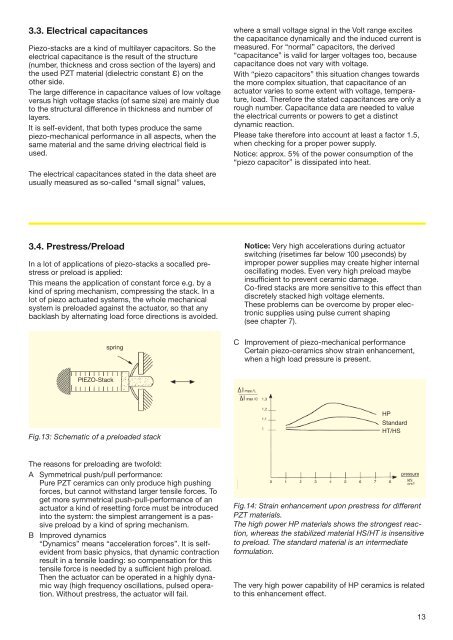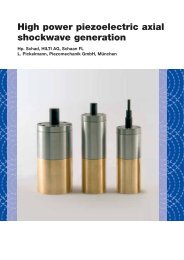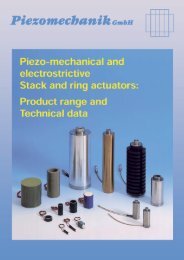231575 Piezo-Mechanics GB
231575 Piezo-Mechanics GB
231575 Piezo-Mechanics GB
You also want an ePaper? Increase the reach of your titles
YUMPU automatically turns print PDFs into web optimized ePapers that Google loves.
3.3. Electrical capacitances<strong>Piezo</strong>-stacks are a kind of multilayer capacitors. So theelectrical capacitance is the result of the structure(number, thickness and cross section of the layers) andthe used PZT material (dielectric constant ε) on theother side.The large difference in capacitance values of low voltageversus high voltage stacks (of same size) are mainly dueto the structural difference in thickness and number oflayers.It is self-evident, that both types produce the samepiezo-mechanical performance in all aspects, when thesame material and the same driving electrical field isused.The electrical capacitances stated in the data sheet areusually measured as so-called “small signal” values,where a small voltage signal in the Volt range excitesthe capacitance dynamically and the induced current ismeasured. For “normal” capacitors, the derived“capacitance” is valid for larger voltages too, becausecapacitance does not vary with voltage.With “piezo capacitors” this situation changes towardsthe more complex situation, that capacitance of anactuator varies to some extent with voltage, temperature,load. Therefore the stated capacitances are only arough number. Capacitance data are needed to valuethe electrical currents or powers to get a distinctdynamic reaction.Please take therefore into account at least a factor 1.5,when checking for a proper power supply.Notice: approx. 5% of the power consumption of the“piezo capacitor” is dissipated into heat.3.4. Prestress/PreloadIn a lot of applications of piezo-stacks a socalled prestressor preload is applied:This means the application of constant force e.g. by akind of spring mechanism, compressing the stack. In alot of piezo actuated systems, the whole mechanicalsystem is preloaded against the actuator, so that anybacklash by alternating load force directions is avoided.springNotice: Very high accelerations during actuatorswitching (risetimes far below 100 µseconds) byimproper power supplies may create higher internaloscillating modes. Even very high preload maybeinsufficient to prevent ceramic damage.Co-fired stacks are more sensitive to this effect thandiscretely stacked high voltage elements.These problems can be overcome by proper electronicsupplies using pulse current shaping(see chapter 7).C Improvement of piezo-mechanical performanceCertain piezo-ceramics show strain enhancement,when a high load pressure is present.PIEZO-StackFig.13: Schematic of a preloaded stackHPStandardHT/HSThe reasons for preloading are twofold:A Symmetrical push/pull performance:Pure PZT ceramics can only produce high pushingforces, but cannot withstand larger tensile forces. Toget more symmetrical push-pull-performance of anactuator a kind of resetting force must be introducedinto the system: the simplest arrangement is a passivepreload by a kind of spring mechanism.B Improved dynamics“Dynamics” means “acceleration forces”. It is selfevidentfrom basic physics, that dynamic contractionresult in a tensile loading: so compensation for thistensile force is needed by a sufficient high preload.Then the actuator can be operated in a highly dynamicway (high frequency oscillations, pulsed operation.Without prestress, the actuator will fail.Fig.14: Strain enhancement upon prestress for differentPZT materials.The high power HP materials shows the strongest reaction,whereas the stabilized material HS/HT is insensitiveto preload. The standard material is an intermediateformulation.The very high power capability of HP ceramics is relatedto this enhancement effect.13





